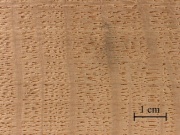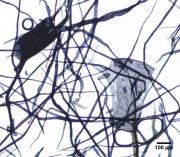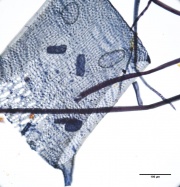Difference between revisions of "Red oak"
JMcGlinchey (talk | contribs) |
|||
| (4 intermediate revisions by 2 users not shown) | |||
| Line 1: | Line 1: | ||
| − | [[File:41_SouthernRedOak.jpg|thumb|Southern Red Oak | + | [[File:41_SouthernRedOak.jpg|thumb|Southern Red Oak (''Quercus rubra'')]] |
| − | |||
| − | (''Quercus rubra'')]] | ||
== Description == | == Description == | ||
| − | Any of several [ | + | Any of several [[oak|oak]] trees, such as ''Quercus rubra, Quercus borealis,'' or ''Quercus falcata'', native to eastern North America. Red oak trees have a hard, coarse-grain wood that is widely used commercially for flooring, furniture, cabinets, paneling, and millwork. |
| − | + | [[File:Redoak vessels 10x.jpg|thumb|Red Oak paper pulp stained with Graff "C" Stain]] | |
| + | [[File:Redoak 40x.jpg|thumb|Red Oak paper pulp stained with Graff "C" Stain]] | ||
== Synonyms and Related Terms == | == Synonyms and Related Terms == | ||
northern red oak (''Quercus rubra, Quercus borealis''); southern red oak (''Quercus falcata''); willow oak (''Quercus phellos''); scarlet oak (''Quercus coccinea''); pink oak; chêne pourpre (Fr.); carvalho vermelho (Port.); quercia rossa (It.) | northern red oak (''Quercus rubra, Quercus borealis''); southern red oak (''Quercus falcata''); willow oak (''Quercus phellos''); scarlet oak (''Quercus coccinea''); pink oak; chêne pourpre (Fr.); carvalho vermelho (Port.); quercia rossa (It.) | ||
| − | == | + | == Physical and Chemical Properties == |
| + | * Heartwood is a light to medium brown, commonly with a reddish cast; paler sapwood is not always sharply demarcated from the heartwood | ||
| + | * Grain is straight, with a coarse, uneven texture | ||
| + | |||
Paper fiber type: hardwood, ring porous. Using transmitted light microscopy, pulp is identified by two sizes of vessels with profuse pitting. The smaller late wood vessels of red oak will stain darker than the earlywood vessels, which can help distinguish pulp from [[white oak]]. Vasocentric trachieds are worm-like and heavily pitted. Perforations are simple. Tyloses are not present. Appearance with [[Graff "C" stain]]: dark blue, but varies with bleaching. Average dimensions of fibers: length 1.47mm, 14-22μm wide. Common pulping method: [[kraft process|kraft]]. | Paper fiber type: hardwood, ring porous. Using transmitted light microscopy, pulp is identified by two sizes of vessels with profuse pitting. The smaller late wood vessels of red oak will stain darker than the earlywood vessels, which can help distinguish pulp from [[white oak]]. Vasocentric trachieds are worm-like and heavily pitted. Perforations are simple. Tyloses are not present. Appearance with [[Graff "C" stain]]: dark blue, but varies with bleaching. Average dimensions of fibers: length 1.47mm, 14-22μm wide. Common pulping method: [[kraft process|kraft]]. | ||
| − | == | + | ==Working Properties== |
| − | + | * Produces good results with hand and machine tools. | |
| − | + | * Has moderately high shrinkage values, resulting in mediocre dimensional stability, especially in flatsawn boards. | |
| − | + | * Can react with iron (particularly when wet) and cause staining and discoloration. | |
| − | + | * Responds well to steam-bending. | |
| − | + | * Glues, stains, and finishes well. | |
| − | |||
| − | |||
| + | ==Resources and Citations== | ||
| + | * The Wood Database: [https://www.wood-database.com/red-oak/ Red oak] | ||
* G.S.Brady, ''Materials Handbook'', McGraw-Hill Book Co., New York, 1971 Comment: p. 555 | * G.S.Brady, ''Materials Handbook'', McGraw-Hill Book Co., New York, 1971 Comment: p. 555 | ||
| Line 30: | Line 32: | ||
* ''The American Heritage Dictionary'' or ''Encarta'', via Microsoft Bookshelf 98, Microsoft Corp., 1998 | * ''The American Heritage Dictionary'' or ''Encarta'', via Microsoft Bookshelf 98, Microsoft Corp., 1998 | ||
| − | * | + | * Virginia Tech Dendrology website at www.fw.vt.edu/dendro/dendrology/main.htm (accessed Oct. 8, 2005) |
* Marja-Sisko Ilvessalo-Pfäffli. ''Fiber Atlas: Identification of Papermaking Fibers'' (Springer Series in Wood Science). Springer, 1995. | * Marja-Sisko Ilvessalo-Pfäffli. ''Fiber Atlas: Identification of Papermaking Fibers'' (Springer Series in Wood Science). Springer, 1995. | ||
Latest revision as of 12:37, 3 October 2022
Description
Any of several Oak trees, such as Quercus rubra, Quercus borealis, or Quercus falcata, native to eastern North America. Red oak trees have a hard, coarse-grain wood that is widely used commercially for flooring, furniture, cabinets, paneling, and millwork.
Synonyms and Related Terms
northern red oak (Quercus rubra, Quercus borealis); southern red oak (Quercus falcata); willow oak (Quercus phellos); scarlet oak (Quercus coccinea); pink oak; chêne pourpre (Fr.); carvalho vermelho (Port.); quercia rossa (It.)
Physical and Chemical Properties
- Heartwood is a light to medium brown, commonly with a reddish cast; paler sapwood is not always sharply demarcated from the heartwood
- Grain is straight, with a coarse, uneven texture
Paper fiber type: hardwood, ring porous. Using transmitted light microscopy, pulp is identified by two sizes of vessels with profuse pitting. The smaller late wood vessels of red oak will stain darker than the earlywood vessels, which can help distinguish pulp from White oak. Vasocentric trachieds are worm-like and heavily pitted. Perforations are simple. Tyloses are not present. Appearance with Graff "C" stain: dark blue, but varies with bleaching. Average dimensions of fibers: length 1.47mm, 14-22μm wide. Common pulping method: kraft.
Working Properties
- Produces good results with hand and machine tools.
- Has moderately high shrinkage values, resulting in mediocre dimensional stability, especially in flatsawn boards.
- Can react with iron (particularly when wet) and cause staining and discoloration.
- Responds well to steam-bending.
- Glues, stains, and finishes well.
Resources and Citations
- The Wood Database: Red oak
- G.S.Brady, Materials Handbook, McGraw-Hill Book Co., New York, 1971 Comment: p. 555
- Dictionary of Building Preservation, Ward Bucher, ed., John Wiley & Sons, Inc., New York City, 1996
- Random House, Webster's Encyclopedic Unabridged Dictionary of the English Language, Grammercy Book, New York, 1997
- The American Heritage Dictionary or Encarta, via Microsoft Bookshelf 98, Microsoft Corp., 1998
- Virginia Tech Dendrology website at www.fw.vt.edu/dendro/dendrology/main.htm (accessed Oct. 8, 2005)
- Marja-Sisko Ilvessalo-Pfäffli. Fiber Atlas: Identification of Papermaking Fibers (Springer Series in Wood Science). Springer, 1995.
- Walter Rantanen. "Fiber ID Course." Integrated Paper Services. June 2013. Lecture.


